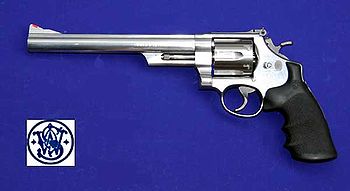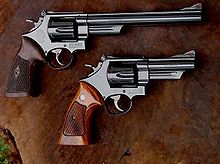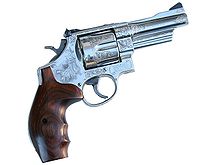- Smith & Wesson Model 29
-
Smith & Wesson Model 29 
Smith & Wesson .44 Magnum Model 629 with 8⅜" barrel — a stainless steel version of the Model 29.Type Revolver Place of origin  United States
United StatesProduction history Manufacturer Smith & Wesson Produced 1955–Present Specifications Barrel length - 4 in (102 mm)
- 6 in (153 mm)
- 8⅜ in (214 mm)
- 10⅝ in (270 mm)
Cartridge Caliber .44 Action Double-action Feed system Six round cylinder Sights 3-dot, adjustable rear The Smith & Wesson Model 29 is a six-shot, double-action revolver chambered for the .44 Magnum cartridge and manufactured by the U.S. company Smith & Wesson. It was made famous by and is still most often associated with the fictional character "Dirty" Harry Callahan from the Dirty Harry series of films starring Clint Eastwood.
The Model 29 was offered with 3", 4", 5", 6", 6½", 8⅜" and, later, 10⅝" barrel lengths as standard models. Other barrel lengths were available either by special order from Smith & Wesson's Custom Shop or custom built by gunsmiths. The 5" barreled variant had a full length underlug. Finish options available included a highly polished blued or nickel-plated surface.
Contents
History
S&W's production of an N (large) revolver frame revolver in .44 Magnum began in 1955, and the Model 29 designation was applied in 1957.[1] It remained primarily the province of handgun enthusiasts, some law enforcement personnel and hunters until 1971, when Clint Eastwood made it famous as "the most powerful handgun in the world" in the movie Dirty Harry. After the movie's release retailers had trouble keeping the Model 29 in stock.[2]
At the time of its introduction, the Model 29 was the most powerful production handgun. There were a number of custom, or wildcat, calibers that were more powerful, as in the old Howdah pistols of the 19th century. Elmer Keith's achievements in maximizing the power and performance of the .44 Special was the inspiration and driving force behind the introduction of the .44 Magnum by Smith & Wesson. His intention for the new round was to be used in sidearms for hunters of large, dangerous game, rather than for self defense, though with today's specialty cartridges, it can be a good defensive round.
The Model 29 will chamber and fire .44 Special cartridges, as the .44 Magnum was developed from the .44 Special. The Magnum case is slightly longer to carry more propellant. This prevents Magnum rounds from being chambered and fired in handguns chambered for the .44 Special.
In the late 1990s, Smith and Wesson discontinued production of many models of revolvers, including the 'basic' Model 29; since then, at various times, the model, in limited or 'custom' configurations, has been manufactured in as many as 10 evolutions.[3]
Variants
The original Model 29 was superseded by the Model 29-1 in 1960, with modifications made to the ejector rod screw. The Model 29-2 replaced it the following year, with one screw that had secured the cylinder stop spring dropped. The barrel length was shortened from 6 1/2" to 6" in 1969. These two versions had what is known as "a pinned and recessed barrel" , where the barrels are screwed in, and secured by a pin through the frame and into a slot in the barrel, allowing easier barrel changes. In 1982, the cost-cutting Model 29-3 dropped counter-bored cylinders (which allow the rim of the cartridges to be fully enclosed by the cylinder) and pinned for crush-fit barrels.[1]
The -4 and -5, produced from 1988 and 1990 respectively had changes to improve durability for heavy use. In 1994 the 29-6 began production, now fitted standard with rubber Monogrips from Hogue to replace the previous wooden items, and standard tapped holes provided for attaching scope mounts. The 29-7 started production in 1998 with changes to the locking mechanism, the firing pin's attachment, and a hammer and trigger produced with a metal injection molding process.[1]
Model 629
Introduced in 1978, the Smith and Wesson Model 629 is a stainless steel version of the Model 29.
The 629 model designation derives from Smith and Wesson's practice of denoting a stainless steel version of one of their already existing designs by placing a 6 in front of the model number of the original weapon. The 629 Classic variant features a full length barrel underlug.
Quiet Special Purpose Revolver
Some S&W model 29s were rebuilt by the AAI Corporation to make the Quiet Special Purpose Revolvers (QSPR). These had new, short, smoothbore barrels (35 mm / 1.375 inch), with .40" / 10mm bore, and with cylinder chambers reamed to accept special QSPR ammunition which externally resembled metal-cased .410-gauge shotgun shells but internally worked as a piston to trap the gases. This special ammunition was made by AAI.[4]
This pistol was developed from 1967 to 1971 to be used by tunnel rats in the Vietnam War. The QSPR was tested on the battlefield in 1969, an improvement and testing program ran 1970 till 1971. At least officially it never entered service. The US withdrawal from Vietnam reduced interest in the QSPR weapon, and the program was ended about 1972.[4]Other variants
- On January 26, 2006, Smith & Wesson announced the 50th Anniversary Model 29.[5] Identical to the previous models except for the gold inlaid trademark on the side cover, the new internal lock mechanism, and a non-fluted cylinder.
- On January 1, 2007, Smith & Wesson announced the reissue of the Model 29 as an engraved model in S&W's Classics line.[6]
- At the 2008 SHOT show, Smith & Wesson introduced the Model 629 Stealth Hunter, a Performance Center custom hunting gun.[7]
Mountain Gun Variation
The Mountain Gun was introduced in 1989 as a lightweight version of the Model 29. The barrel profile is a reprise of the post World War II designs.
A Smith & Wesson Model 629 called the "Trail Boss" was produced, having a short barrel and Hogue grips.
See also
References
- ^ a b c John Taffin. Gun Digest Book of the .44. pp. 147–150. ISBN 0896894169. http://books.google.ca/books?id=VDCkAoN1pBQC&pg=PA147.
- ^ Hornaday, Ann (Jan 17, 1999) "Guns on film: a loaded issue ", Baltimore Sun. Retrieved 2010-04-05.
- ^ Smith, Clint (2007). The do-all death-ray: SDM's custom .44 Magnum. 24.
- ^ a b Popenker, Max R. "Smith & Wesson/ AAI Quiet Special Purpose Revolver/ QSPR/ Tunnel Revolver ", world.guns.ru. Retrieved 2010-04-05.
- ^ Smith & Wesson press release announcing the Model 29 Anniversary Edition.
- ^ "Smith & Wesson Classics: Model 29 Engraved". Smith & Wesson. Archived from the original on 2007-09-27. http://web.archive.org/web/20070927213453/http://www.smith-wesson.com/wcsstore/SmWesson/upload/other/SW2007_Classics+Model+29.pdf.
- ^ Smith & Wesson Model 629 Night Hunter Introduced.
External links
Categories:- .44 Magnum firearms
- Revolvers
- Smith & Wesson revolvers
- Dirty Harry
- 1955 introductions
- Weapons of the Vietnam War
Wikimedia Foundation. 2010.




